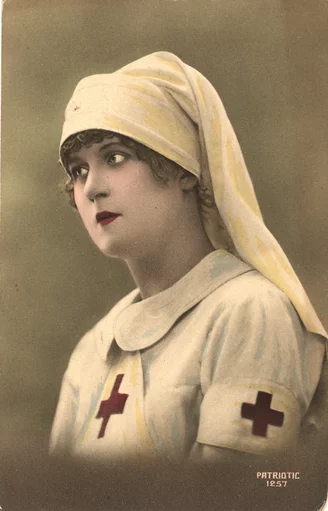The pandemic is over and we are moving on!
Even I can’t tell if I’m being sarcastic or serious, and like almost everyone I have mixed feelings about the last three years and what they portend for the future.
No more daily or weekly reminders about what we should be doing, what we should wear, how we should act, what we should take, who we should hang out with — FREEDOM! I’m ready, especially since my job involves being the person who tells you what to do. It’s not my natural temperament and really, you’d hope that most people are good and will make responsible choices.

She wears a cross, but you wouldn’t cross her! Pictured is the prototypical modern nurse — slightly world-weary, sexy as hell, endlessly bemused at the myriad variations on the theme of “being human” she encounters on the daily. Before this lady the nurses all dressed like nuns and slapped you with a ruler. Photo: Public domain, via the National Library of Medicine.
And we have reason to still be hopeful for that. The pandemic made huge changes in our society - we are all a little different. While hindsight is 20/20, there are some clear needs for the next time we face a similar crisis: knowledge, credible information, critical thinking, no jumping to conclusions, and kindness.
If we keep looking at public health issues in the right way, and kindly bring the stragglers along, we’ll be much better prepared next time, right? RIGHT??? To my readers, keep up the excellent work.
With the end of the official COVID pandemic, this will be my last column on LoCO — for now. If things heat back up, information is hard to find, or some other virus rears it’s head, I’ll come back and politely remind you to wash your hands.
So for now, I want to leave you with a grab bag of resources to guide you as the official journey ends, and we each begin our own individual health adventures, ready or not.
###
Numbers of COVID-19 vaccinations, cases, hospitalizations, and deaths that have been reported in the U.S. are available here for anyone who wants to keep up with the information. The map of the U.S. gives an idea of transmission rates in each state or region, and you can also use the tracker to see trends in your community. The community-level information is updated weekly, while other data is updated daily.
Prevent, prevent, prevent! Vaccines are still high on the list of preventative measures against COVID-19. Aside from that, avoiding people who are sick with a viral illness, improving ventilation and taking activities outside if possible while community transmission is high are all effective strategies to stay healthy. Try to keep your body strong by moving every day, eating right, staying hydrated, and getting plenty of sleep.
Because not everything that “happens in Vegas stays in Vegas,” you may want to get tested for COVID if you start feeling “off.” If you are tired or have a sore throat, chest congestion, runny nose or fever, please stay home from work and get tested.
Where can you get tested? Now that the community testing that has been available for years has closed, there are some other options for testing that I was able to find (click here). Rapid tests are available through public health departments, or free tests can be mailed to you (click here).
If you do test positive, it is recommended that you get medical attention and consider a treatment option. Don’t use the emergency department unless you are having trouble breathing, persistent pain or pressure in the chest, new confusion, inability to stay awake or bluish lips or face. Know when to go.
If you do not have a provider you can use this service to see a provider and get prescribed appropriate treatment.
What is the appropriate treatment? The National Institutes of Health have a website with updated treatment guidelines; the FDA has some information here and the CDC have some information here.
Have we seen the last of COVID? Well, no, no we haven’t. Check the tracker for that info, but even if COVID was gone, pandemics happen, and we need to be prepared for the future. Emerging infectious diseases have been discovered over the last several years worldwide, including Ebola, Zika, Middle East respiratory syndrome coronavirus (MERS-CoV), and Chikungunya, in addition to COVID-19. Being prepared means having the plans, resources, and capacity to prevent, detect, and respond to any infectious disease threats. What have people been saying about preparing for the next one?
- Strengthen the healthcare systems - infrastructure, supplies, workforce
- Technology - investing in research and development of tests and vaccines; streamlining regulatory processes; building manufacturing capacity; ensuring equitable access; encouraging international collaboration and cooperation
- Public awareness and education-providing accurate and timely information in culturally appropriate ways; encouraging behavior change; empowering communities; increasing access to mental health resources; investing in health literacy
Here is a reputable place to keep up with COVID news and information.
One last thing. Oh, I shouldn’t do it, but I’m gonna. What about those masks??? Some people heard that “masks don’t work.” I am leaving you with the resources to do what you want, but I do want people to know that after working in healthcare for over 40 years (yes, I was 16 when I started working in healthcare), a lot has happened in the world of personal protective equipment and recommendations for healthcare workers to protect themselves. Just know that if I see you in public, also wearing your mask, I’ll give you a big warm smize.
Take care of yourselves and each other. Wash your hands. Be safe!
###
Michelle Lewis-Lusso (she/her) is an Infection Prevention and Control nurse at United Indian Health Services, serving the 11,000+ clients and staff at their seven area clinics. She will be wearing her mask and getting some exercise, and encourages you to do the same.
CLICK TO MANAGE